The Winterton connection

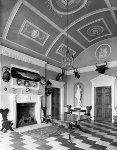 The
Turnour family lived at
Shillinglee
Park near Godalming in Surrey,
a red brick early Georgian house designed by Thomas Steel in 1735 and
extended in the 1770s. [It was burnt out in a fire in 1943 when
Canadian troops were billeted there, and in 1975 was converted into
three large apartments.]
The
Turnour family lived at
Shillinglee
Park near Godalming in Surrey,
a red brick early Georgian house designed by Thomas Steel in 1735 and
extended in the 1770s. [It was burnt out in a fire in 1943 when
Canadian troops were billeted there, and in 1975 was converted into
three large apartments.]
They
were major landowners in the parish, owning several hundred houses,
including the Chapman estate, which produced rents of £15,000 a
year before the First World War. These properties had come into the
family from Jane Chapman, daughter of a London merchant, who married
the second Earl Winterton in 1781, and enabled the family to live in
style for several generations. As the 6th Earl's biographer wrote, Few,
during the nineteenth century anyway, could maintain a large country
estate with its sole income. The fiction was that the 'broad acres'
supported the 'great' house but they did not. The real money came from
mines, bits of London, slums in industrial cities and other
investments. Jane Chapman's contribution consisted of a number of mean
streets in the parish of St. George's-in-the-East. The only features to
relieve the monotony of the small houses were some mulberry trees,
remains of many planted in Stepney and Poplar 200 years ago in yet
another unsuccessful attempt to breed silkworms in Britain. But
mulberry trees will flourish where silkworms will not and the ailanthus
moth which will do well here does not yield useful silk.
Edward Turnour (1883-1962), educated
at Eton and New College Oxford (where he read law), was elected in a by-election as
Conservative MP for Horsham in 1904 while still at university,
thus becoming the 'Baby of the House'. He inherited
two titles in 1907 - 6th Earl of Winterton and Baron Turnour - but
since these were Irish it did not
debar him from the House of Commons. (In 1913 R.S. Pengelly wrote to Notes & Queries reporting that when he addressed a 1910 General Election campaign meeting in St George-in-the-East, where he is a considerable owner of house property, the proceedings were lively, owing to a large opposition element, and there
were some very smart interruptions by 'voices'; after some especially
strong statement by the orator, there carne 'a voice' - 'You certainly
are a nut', followed by roars of laughter. This appeared in a Daily
News report, and was the first occasion when I saw the word [nut] in print.) In the First World War he served with the
Sussex Yeomanry in Gallipoli, with the Imperial Camel Corps in Egypt, and eventually with
T. E. Lawrence in the Hejaz, and was twice mentioned in dispatches.
Back
in Parliament, he served as under-secretary for India, Chancellor of
the
Duchy of Lancaster, deputy to the Secretary of State for Air and
Paymaster General, and was for a short time in the Cabinet. He was a
member of 'The Other Club' and a staunch supporter of Winston
Churchill. From 1945-51 he was 'Father of the House' - the longest-serving MP - latterly supporting a distinctive green eye-patch. (Which
other MPs have been both 'Baby' and 'Father'?) Here are some images of
him (he was 6' 4" tall, and continued to wear the high-buttoned jackets
and narrow trousers of his younger days):
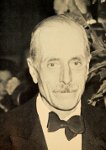
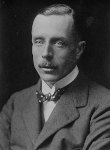
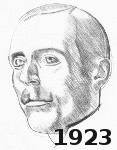

 1907/8 - after Frederick Drummond Niblett ('Nibs')
1907/8 - after Frederick Drummond Niblett ('Nibs')- 1908 - watercolour by Sir Leslie Ward, Vanity Fair 16 September
- 1923 - pencil portrait commissioned by T.E. Lawrence for The Seven Pillars of Wisdom - it took Lawrence some time to persuade him to sit for this; in February 1923 he wrote It's V. G. to
hear Winterton has yielded up his fort ... and I hope that the
taking-over proceedings will not be as fearful as you expect. He's hot,
is Winterton: and he'll be an impatient and unconscionable sitter.
- undated - from his career in Parliament
- undated - from his biography.
From 1942 to his death Earl Winterton was a trustee, and
latterly chairman, of the London Mosque Fund which built what is now
the East London Mosque. During
the war - mindful of the small, but growing number of Muslims in East
London, but perhaps more particularly also of the many Russian Muslims
serving in the Red Army - he
commented in Parliament that they did not like the Allies calling
the war a 'Christian Crusade' as they found both terms
objectionable. On retirement, he
was given an English peerage - which died with him, as
he was childless. Here
is a fuller biography, and see Alan Houghton Brodrick Near to Greatness: A Life of the Sixth Earl Winterton (Hutchinson 1965) based on conversations from his latter years.
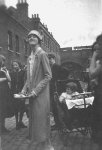 In 1924 he married the Hon (Cecilia) Monica Wilson, daughter of Baron Nunburnholme. She played the rôle of dutiful wife, attending functions in town and
country, unless she was 'too ill' to attend (as in this report of the dedication of the parish's war memorial in 1924). She is pictured left
on an inter-war visit to Tillman Street. In 1945 she stood as a
Conservative councillor for Westminster; she died in 1974. There's a
cryptic reference to her in a letter of [Sir] Isaiah Berlin, written from All Souls' College Oxford to the Irish writer Elizabeth Bowen on 30 November 1933: ...
I've been ill in bed for a fortnight with a disease which the doctor
failed to diagnose: my neighbour ... thinks its the bacillus abortivus,
which when it attacks cattle is a harmless cause of sterility. (Please
forgive me. I write on & on as I talk, & how tiresome that must
often be. But I cannot think of stoppoing therefore) but
in Lady Winterton produced my symptoms.
In 1924 he married the Hon (Cecilia) Monica Wilson, daughter of Baron Nunburnholme. She played the rôle of dutiful wife, attending functions in town and
country, unless she was 'too ill' to attend (as in this report of the dedication of the parish's war memorial in 1924). She is pictured left
on an inter-war visit to Tillman Street. In 1945 she stood as a
Conservative councillor for Westminster; she died in 1974. There's a
cryptic reference to her in a letter of [Sir] Isaiah Berlin, written from All Souls' College Oxford to the Irish writer Elizabeth Bowen on 30 November 1933: ...
I've been ill in bed for a fortnight with a disease which the doctor
failed to diagnose: my neighbour ... thinks its the bacillus abortivus,
which when it attacks cattle is a harmless cause of sterility. (Please
forgive me. I write on & on as I talk, & how tiresome that must
often be. But I cannot think of stoppoing therefore) but
in Lady Winterton produced my symptoms.
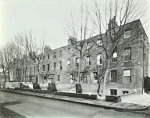 One 'memorial' in the parish is the row of six London plane trees
in Cable Street, opposite the estate office [now Hawksmoor Mews], planted by one of Lord
Winterton's staff, William Whiting (father of the late Edith Wyeth).
They are pictured here in 1945 outside the now-demolished houses at 185-201. The Winterton's patronage of the parish
was sincere and relatively enlightened despite their vested interests as property owners. In 1934 a block of 15 flats in Walburgh
Street, off what is now Bigland Street, designed in progressive style
by Joseph Emberton as 'philanthropic housing', was named Turnour House:
see here for pictures.
One 'memorial' in the parish is the row of six London plane trees
in Cable Street, opposite the estate office [now Hawksmoor Mews], planted by one of Lord
Winterton's staff, William Whiting (father of the late Edith Wyeth).
They are pictured here in 1945 outside the now-demolished houses at 185-201. The Winterton's patronage of the parish
was sincere and relatively enlightened despite their vested interests as property owners. In 1934 a block of 15 flats in Walburgh
Street, off what is now Bigland Street, designed in progressive style
by Joseph Emberton as 'philanthropic housing', was named Turnour House:
see here for pictures.
[Nicholas and Ann Winterton, the disgraced Tory MPs, are no relation.]
Back
to History
| Back to Chapman Street



 The
Turnour family lived at
Shillinglee
Park near Godalming in Surrey,
a red brick early Georgian house designed by Thomas Steel in 1735 and
extended in the 1770s. [It was burnt out in a fire in 1943 when
Canadian troops were billeted there, and in 1975 was converted into
three large apartments.]
The
Turnour family lived at
Shillinglee
Park near Godalming in Surrey,
a red brick early Georgian house designed by Thomas Steel in 1735 and
extended in the 1770s. [It was burnt out in a fire in 1943 when
Canadian troops were billeted there, and in 1975 was converted into
three large apartments.] 



 1907/8 - after Frederick Drummond Niblett ('Nibs')
1907/8 - after Frederick Drummond Niblett ('Nibs') In 1924 he married the Hon (Cecilia) Monica Wilson, daughter of Baron Nunburnholme. She played the rôle of dutiful wife, attending functions in town and
country, unless she was 'too ill' to attend (as in this report of the dedication of the parish's war memorial in 1924). She is pictured left
on an inter-war visit to Tillman Street. In 1945 she stood as a
Conservative councillor for Westminster; she died in 1974. There's a
cryptic reference to her in a letter of [Sir] Isaiah Berlin, written from All Souls' College Oxford to the Irish writer Elizabeth Bowen on 30 November 1933: ...
I've been ill in bed for a fortnight with a disease which the doctor
failed to diagnose: my neighbour ... thinks its the bacillus abortivus,
which when it attacks cattle is a harmless cause of sterility. (Please
forgive me. I write on & on as I talk, & how tiresome that must
often be. But I cannot think of stoppoing therefore) but
in Lady Winterton produced my symptoms.
In 1924 he married the Hon (Cecilia) Monica Wilson, daughter of Baron Nunburnholme. She played the rôle of dutiful wife, attending functions in town and
country, unless she was 'too ill' to attend (as in this report of the dedication of the parish's war memorial in 1924). She is pictured left
on an inter-war visit to Tillman Street. In 1945 she stood as a
Conservative councillor for Westminster; she died in 1974. There's a
cryptic reference to her in a letter of [Sir] Isaiah Berlin, written from All Souls' College Oxford to the Irish writer Elizabeth Bowen on 30 November 1933: ...
I've been ill in bed for a fortnight with a disease which the doctor
failed to diagnose: my neighbour ... thinks its the bacillus abortivus,
which when it attacks cattle is a harmless cause of sterility. (Please
forgive me. I write on & on as I talk, & how tiresome that must
often be. But I cannot think of stoppoing therefore) but
in Lady Winterton produced my symptoms. One 'memorial' in the parish is the row of six London plane trees
in Cable Street, opposite the estate office [now Hawksmoor Mews], planted by one of Lord
Winterton's staff, William Whiting (father of the late Edith Wyeth).
They are pictured here in 1945 outside the now-demolished houses at 185-201. The Winterton's patronage of the parish
was sincere and relatively enlightened despite their vested interests as property owners. In 1934 a block of 15 flats in Walburgh
Street, off what is now Bigland Street, designed in progressive style
by Joseph Emberton as 'philanthropic housing', was named Turnour House:
see here for pictures.
One 'memorial' in the parish is the row of six London plane trees
in Cable Street, opposite the estate office [now Hawksmoor Mews], planted by one of Lord
Winterton's staff, William Whiting (father of the late Edith Wyeth).
They are pictured here in 1945 outside the now-demolished houses at 185-201. The Winterton's patronage of the parish
was sincere and relatively enlightened despite their vested interests as property owners. In 1934 a block of 15 flats in Walburgh
Street, off what is now Bigland Street, designed in progressive style
by Joseph Emberton as 'philanthropic housing', was named Turnour House:
see here for pictures.